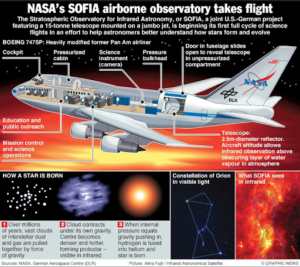In news– Recently, National Aeronautics and Space Administration (NASA) has said that it would shut down the operations of Stratospheric Observatory for Infrared Astronomy (SOFIA) mission by September 30, 2022.
About SOFIA mission-
- SOFIA is a 2.7-meter infrared telescope sitting inside a Boeing 747SP airplane, flying at an altitude of 38,000-45,000 feet above the surface.
- Flying into the stratosphere at 38,000-45,000 feet puts SOFIA above 99 percent of Earth’s infrared-blocking atmosphere, allowing astronomers to study the solar system and beyond in ways that are not possible with ground-based telescopes.
- It is the world’s largest flying telescope that confirmed the presence of water on the Moon.
- It’s the second-most expensive astrophysics mission, according to the NASA’s Financial Year 2023 budget estimates report.
- SOFIA is a collaboration between NASA and the German Space Agency (DLR) (the German Space Agency contributed 20 percent of the costs).
- Since its inception in 2014, SOFIA has been collecting data to understand star birth and death and the formation of new solar systems.

- It has also been keeping a close eye on planets, comets and asteroids in our solar system, nebulas and galaxies, celestial magnetic fields and black holes at the centre of galaxies.
- It was designed to observe cosmic objects in far-infrared wavelengths. This allows researchers to watch star formation by looking through huge, cold clouds of gas.
- NASA’s decision to shut down SOFIA closely follows the White House’s 2023 federal budget request released in March 2022, which did not allocate money to SOFIA.
- Its annual operations Budget is the second-most expensive operating mission in Astrophysics, yet the science productivity of the mission is not commensurate with other large science missions.
Important discoveries of the mission-
- The project has generated 309 scientific studies.
- In 2020, NASA announced that SOFIA discovered water molecules (H2O) on the sun-facing side of the Moon.
- The site is the Clavius Crater, located in the Moon’s southern hemisphere. The telescope’s data suggested that the site contained water in concentrations of 100 to 412 parts per million — roughly equivalent to a 12-ounce bottle [355 millilitres] of water.
- In 2019, SOFIA also discovered helium hydride — the first molecule formed in the Universe almost 14 billion years ago.
- Many crucial processes in the history of the universe leave their signatures in the far-infrared and SOFIA is the only observatory that can probe this important wavelength range for the next decade.
- SOFIA is the only instrument after Herschel that has the capability of observing singly ionized carbon, which is now understood to be an important tracer of the molecular gas in the local universe.
- It has also identified atmospheric circulation patterns in Jupiter.
- It also mapped the magnetic field within G47, one of Milky Way’s spiral arms.
- Magnetic fields can potentially set the rate at which stars form in a cloud.
















